Introduction
After spending the past year or so with our octoScope-based wireless testbed, I was ready to listen when octoScope suggested upgrading.
The V1 testbed uses octoBox 26" wide chambers, which have proved to be a bit too tight, especially as the size of routers have grown. The desired 8" distance between router under test and the chamber antennas has not been achieved on more than one occasion.
Enter the 38" wide octoBox Stackable anechoic chamber. It measures 24" x 38.35" x 31.2" vs. 18" x 26.35" x 25.2" for the 26" octoBox. The photo below shows the new stack, with a new 38" wide octoBox MPE (Multi Path Emulator) sandwiched between the upper and lower chambers. The key features of the new configuration are described in the octoScope video below.
The Stack
The new stack includes octoScope’s new quadAtten programmable attenuator module, which replaces the multiple Vaunix Lab Brick attenuators in the old setup. Dual-shielded cables are also used externally, providing better shielding for test environments with a lot of RF activity. The stack sits on a sturdy base with honkin’ big casters that provide very easy rolling. That’s an APC Back-UPS 550 and TRENDnet TEG-S80g Gigabit switch sitting on the base in the photo.
Everything runs off the UPS so that power glitches don’t interrupt testing. The TRENDnet switch connects the two testbed computers to the SNB LAN and each other. RealVNC is used to remotely access the two testbed computers.
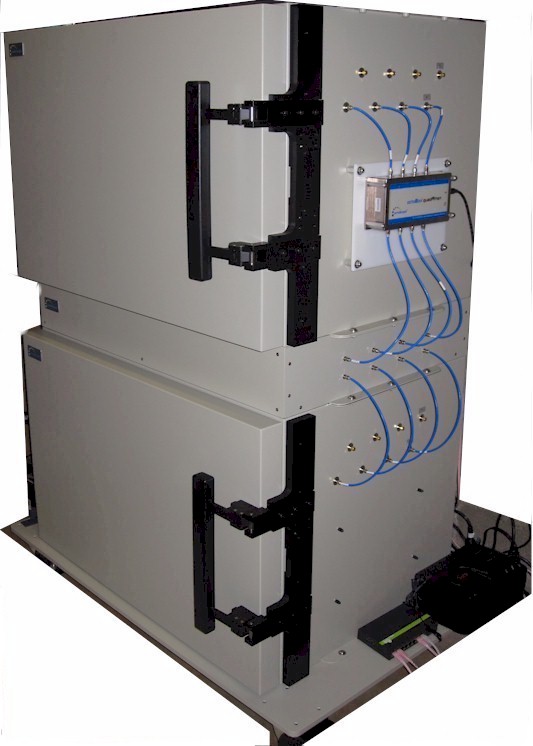
SmallNetBuilder Wireless Testbed V2
Note that the new testbed can handle four RF paths vs. three in the old testbed. This will let us test the new crop of 4×4 AC2350 routers, like ASUS’ RT-AC87 that has been available for just about a week as I write this. The 38" octoBoxes are much roomier inside as the photo below shows.

SmallNetBuilder Wireless Testbed V2 inside
Everything is connected as shown in the diagram below. As is our standard, the new process uses Ixia’s IxChariot to generate traffic and measure throughput.
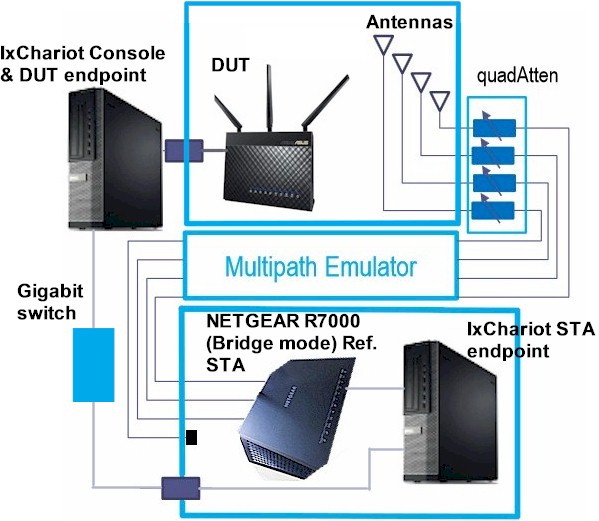
octoBox based WLAN Testbed block diagram
Computers
The V2 testbed has gotten a computer upgrade, too. The Dell Optiplex 790 Small Form Factor (Core i5-2400 @ 3.1 GHz) formerly used in the lower chamber now connects to the upper chamber and runs the IxChariot console and the IxChariot test endpoint for the Device Under Test (DUT). The Test STA computer is also a Dell Optiplex SFF machine, but a 9010 model with Core i5 3570 CPU @ 3.4 GHz. After a briefly wrestling with Windows 8 quirks, I decided to stay with Windows 7 Pro on both systems.
Both computers have a TP-LINK TG-3468 PCIe Gigabit Ethernet adapter (Realtek RTL8168B based) installed to provide a second port. This adapter replaces the aging Intel CT’s in the V1 testbed that were starting to become unreliable. One port connects to the SNB LAN for control, the other to the DUT or reference STA for test data.
Upper Chamber
The signals from the device under test (DUT) are picked up by four omnidirectional unity-gain 2.4 / 5 GHz dual-band antennas, shown on the right in the photo below. Because the test client is still 3×3, only three antennas are currently used. The fourth signal path is sealed with connector caps on both ends. You can see there is now lots of room in the cabinet, even with the largest router seen to date, NETGEAR’s R8000 Nighthawk X6.
Some readers pointed out that the all-vertical antenna orientation in the V1 testbed might provide a performance edge to routers with vertical antenna polarization. So in the V2 testbed, only one antenna remains vertical; the other two are set at 45°. The two Ethernet and USB connectors and quad power outlets are all filtered so that RF gets neither in nor out.
That’s a SNB-installed bamboo rod running across the top of the chamber. It is used to hang the power and Ethernet DUT cables so that they don’t get hung up as the turntable rotates the DUT. It’s also handy to hang an LED worklight used when setting up routers for test. octoScope provided a plastic crossbar for this, but it was too tall and barely missed the top of the ASUS RT-AC68U’s antennas.
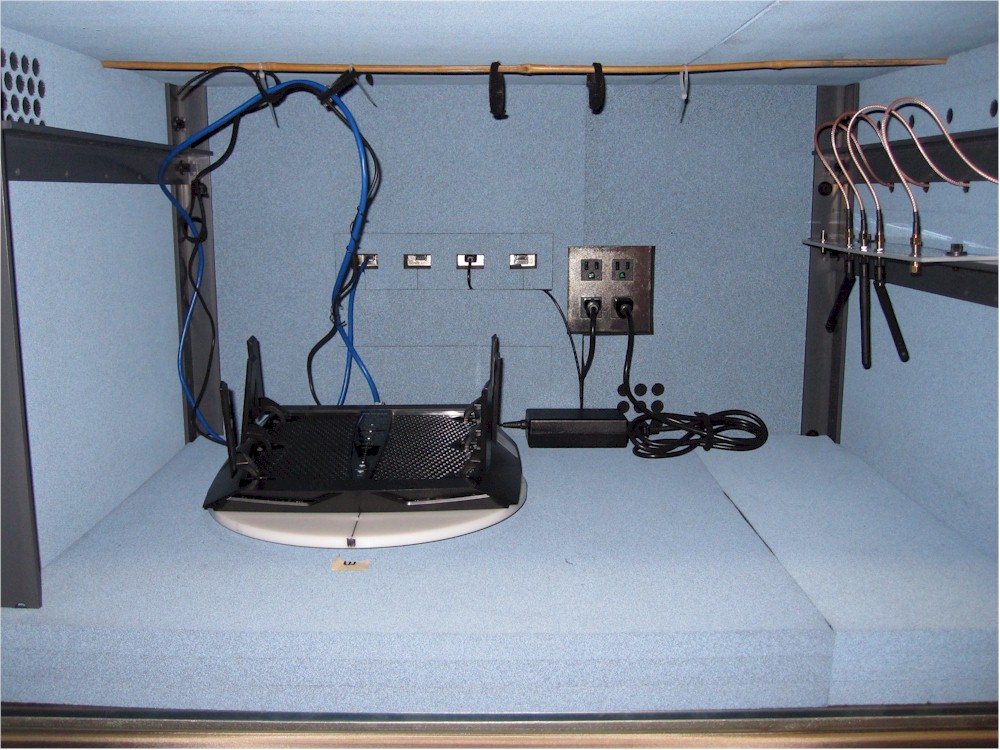
NETGEAR R8000 router under test inside the upper test chamber
I ran many experiments before settling on the antenna configuration. I found the larger octoBox tended to yield lower throughput than the smaller box, especially for the 5 GHz band. Experiments showed the lower throughput was primarily due to higher path loss from the greater distance between the DUT and chamber antennas.
I found the slightly closer antenna spacing helped compensate for some of the distance-caused path loss. The antenna array is centered on the chamber turntable. Distance from center of turntable to chamber antennas is 18 inches (45.72 cm).
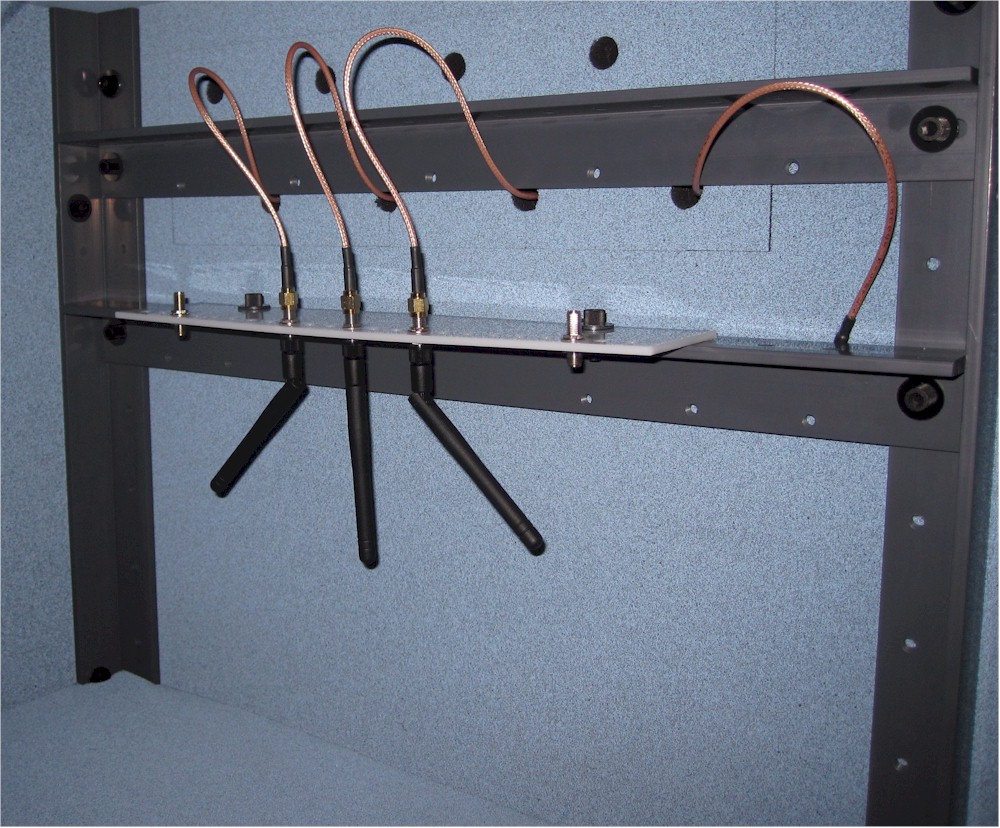
Upper chamber antenna detail
Speaking of which, the octoBox-TT is a new feature in the upper chamber, used to rotate the DUT during testing. Its exact use is described in How We Test Wireless Products – Revison 8. The center of the turntable is approximately XX" from the chamber antennas.
Between
The three antennas are connected to octoScope’s new quadAtten programmable attenuator used to adjust signal level to simulate distance. The quadAtten can be seen in the first photo above, mounted on the side of the upper test chamber. The quadAtten outputs are connected to a SMA connectors on the octoBox MPE, which sits between the upper and lower chambers. The MPE emulates multipath using IEEE 802.11n/ac indoor channel models B or C. The lower set of SMA connectors on the MPE connect directly to the lower test chamber, which holds the standard wireless test client (STA).
Lower Chamber
The V2 testbed retires the ASUS PCE-AC66 AC1750 class PCI-e board used as the reference client in V1 testbed. After careful consideration, NETGEAR’s R7000 Nighthawk running firmware V1.0.3.60_1.1.27 configured in client bridge mode was selected as the new testbed reference client.
The R7000 is directly cabled to the MPE using dual-shielded cables. Direct cabling is necessary to ensure high enough signal levels in both 2.4 and 5 GHz so that maximum link rates can be reached. Since the R7000 is an AC1900 class router, we now can test the 2.4 GHz side of AC1900 routers to their full potential. The R7000 is connected via Gigabit Ethernet to the Dell Optiplex. The R7000 is managed via web browser from the lower chamber computer. The computer is accessed remotely via VNC.
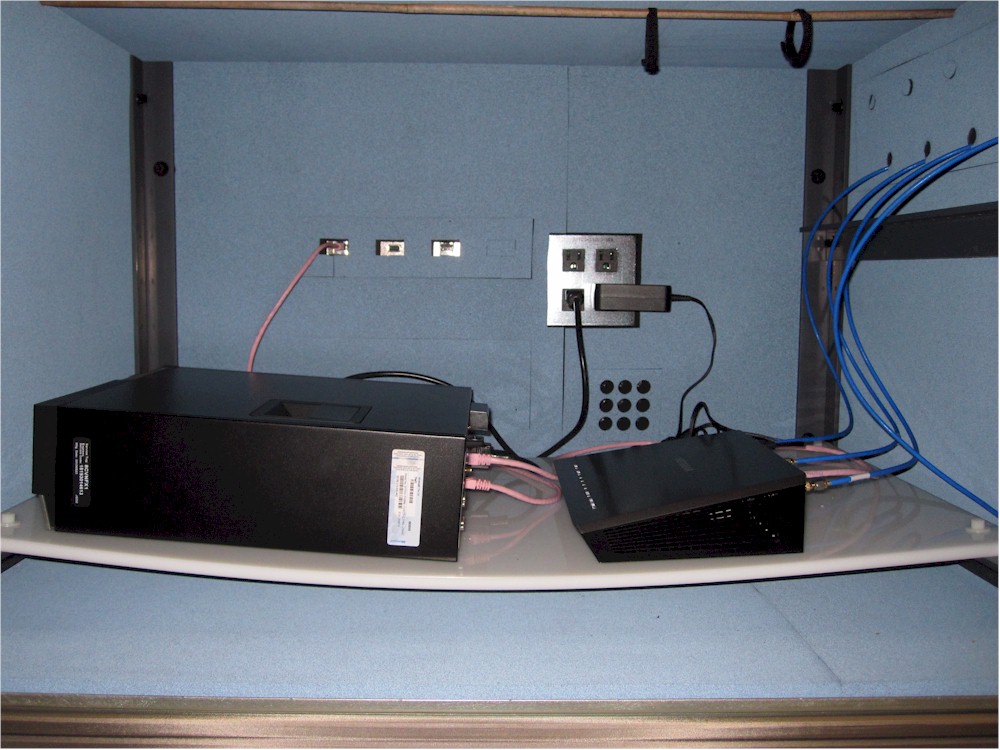
Lower Test Chamber view
That concludes the tour of the V2 testbed. How We Test Wireless Products – Revison 8 describes how we use it.
